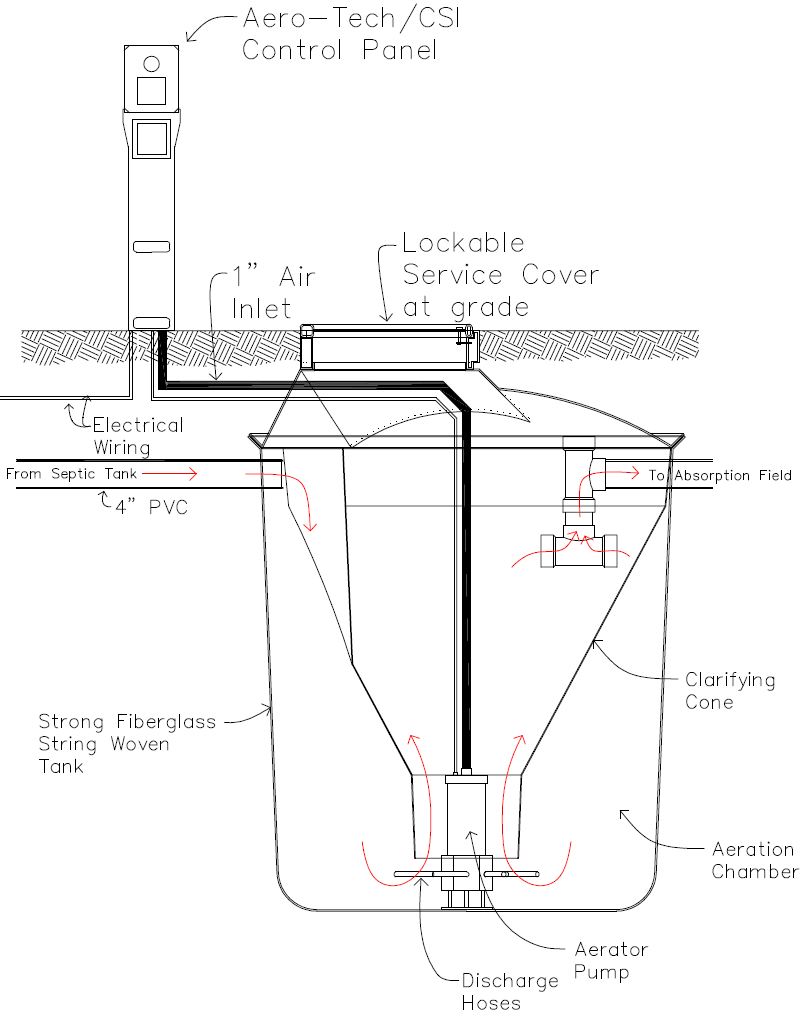Systems Comparison

Treatment:
Typical Influent (Septic Tank Effluent)
BOD5: 230 mg/L
TSS: 210 mg/L
Expected AERO-TECH Effluent Quality
cBOD5: 5 mg/L
TSS: 6 mg/L
BOD5
BOD5 stands for “5-day Biochemical Oxygen Demand.” Although those words sound a bit intimidating, the concept is pretty familiar for most people. Just as we breathe, microbes also breathe, and they use oxygen when they breathe. The BOD test is a way to measure how much oxygen is used as microbes breathe as they eat the contaminants in wastewater. The more contaminants in the wastewater, the more oxygen is needed. So a high BOD indicates high concentration of contaminants in the wastewater that the microbes have eaten. The “5-day” means that the oxygen content is measured when the test starts, and again at the end of 5 days. The difference in the oxygen content on the first day and on the last day is used to calculate the Biochemical Oxygen Demand of the wastewater.
TSS
TSS stands for “Total Suspended Solids.” TSS is essentially a measure of how “dirty” the water is in terms of solid material suspended in the water. The more solid that is suspended in the water, the higher the TSS value. TSS is measured by weighing a clean, dry filter, then pouring the sample through the filter, drying it, then weighing the dirty dry filter. The amount of weight gained is used to calculate the suspended solids concentration.
BEWARE!!!
The outputs of various Waste Water Treatment systems vary SIGNIFICANTLY! It is imperative that before you choose a system that you know the quality of output. Outputs are measured in BOD5 and TSS.
Here are some additional questions that every homeowner should ask before choosing a system:
- Noise
How noisy is the system? - Odor
Does the system have a reputation for being smelly? - Electricity Cost
How much will the electricity cost me, each and every month, to run the system? - Irrigation
May I use the water from the system to irrigate my lawn? - Installation
Is it expensive to install the system? - Visual Impact
What am I going to see in my back yard? How much of my yard will the system occupy? - Reliable Performance
Will my system work properly and reliably, even when I'm using it a lot (when I'm doing laundry or entertaining guests)? How about when I'm not using it (when I go on vacation)? - Alarms
If something goes wrong with the system, is there an alarm? - Maintenance Costs and Serviceability
How many service calls does the system require a year? How often will the system have to be pumped and how much will it cost? Are the system and its components easy for service providers to reach and clean? - Equipment Replacement Costs
Are there components in the system (such as pumps, filters, blowers, or aerators) that will have to be replaced within a few years? What are the repair/replaement costs for those components? - Warranties
How long is the warranty for the treatment system? - Outputs
How clean is the discharge water? (Measured in BOD + TSS) - Septic Tank Cleaning/Pumping
How often does the septic tank need pumped?
| AERO-TECH | Compressor & BLOWER ATU | |
|---|---|---|
|
Noise |
Slight hum from Control panel (outside) |
Loud blower or compressor runs 24 hours/day. Typically in the kitchen |
|
Odor |
None |
Typical |
|
Electricity Cost |
$7.00/mo (Central America) |
$20.00-$40.00/mo (Central America) |
|
Irrigation |
Approved for above ground irrigation of lawn/landscape |
Not approved |
|
Installation |
Basic inexpensive gravity underground or irrigation/sprinkler system |
Requires underground discharge (drip systems) that require a pump, large area and expensive to install |
|
Visual Impact |
System footprint typically measures 12 m2. Control panel on post, and 3 ground-level lids |
System footprint similar to our system. Control panel on post, 4 ground-level lids |
|
Reliable Performance |
System can handle normal household uses and occupancy- effective on FOG |
Air filters become clogged decreasing efficiency. FOG will decrease efficiency. |
|
Alarms |
Homeowner must turn off alarm & call service provider 24 hour reserve capacity; system usable and safe |
Homeowner must turn off alarm and call Service Provider No Reserve -untreated water is released immediately |
|
Maintenance Costs and Serviceability |
Two service calls in first year. Annual service call thereafter 4 year average pumping interval. No filters to change! At-grade access of treatment unit for ease of servicing |
Two service calls required per year: 6-month servicing interval for all air filters 6 month pumping interval. Check your local pumping costs! Below-grade installation of diffuser/stones make servicing of components difficult |
|
Equipment replacement |
Expected 5 to 6 years on pump |
6-month life cycle on air filters Expected 2 to 3 year life cycle on blowers or compressors |
|
Warranties |
5 years |
Typically 2-year warranty |